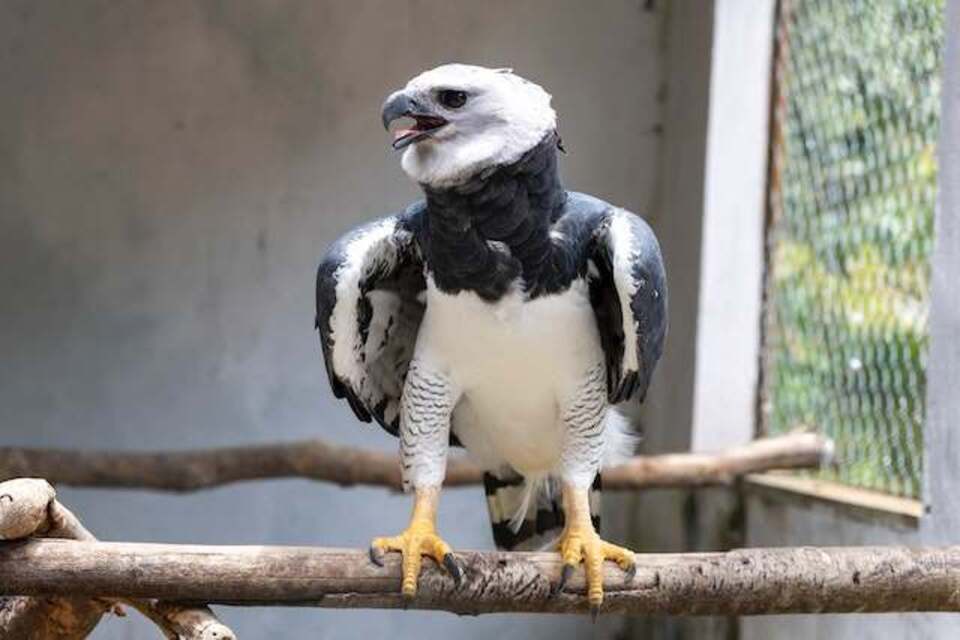If you’ve ever wondered, do eagles eat spiders? the answer is yes, but it’s quite rare. While eagles primarily hunt fish, small mammals, and birds, they have been known to occasionally eat spiders if the opportunity arises. Their diet is typically based on larger prey, but their versatile hunting skills mean they can adapt to different food sources. In this article, we’ll explore the types of prey eagles typically hunt and how they occasionally include unexpected meals like spiders.
Click the Play button below to listen to our podcast:
Table of Contents
Eagle’s Diet: A Feast Fit for Kings
From Fish to Mammals: Eagles’ Menu
Eagles are renowned for their adaptability when it comes to food sources. Their diet is as diverse as the habitats they inhabit, ranging from coastal areas to mountainous regions and everything in between. While fish often take center stage in an eagle’s diet, particularly for species like the Bald Eagle, these versatile predators don’t limit themselves to aquatic fare.
Waterfowl, such as ducks and geese, frequently find themselves on the eagle’s menu. These birds provide a substantial meal and are often abundant in the wetland areas where many eagle species thrive. Small mammals also play a significant role in eagle diets. Rodents, squirrels, and rabbits are common targets, especially for eagles inhabiting more terrestrial environments. In some cases, eagles have been observed taking on larger prey, such as raccoons or even young deer, showcasing their impressive strength and hunting prowess.
Reptiles and amphibians aren’t safe from eagle predation either. Frogs, snakes, and even turtles can fall victim to an eagle’s sharp talons and beak. This diverse array of prey items demonstrates the eagle’s ability to adapt its hunting strategies to whatever food sources are available in its territory.
Interestingly, eagles are not above scavenging when the opportunity presents itself. Carrion, including roadkill or the remains of other predators’ meals, can provide an easy meal for these opportunistic birds. This behavior not only showcases their adaptability but also highlights their important role in ecosystem health, helping to clean up and recycle nutrients from deceased animals.
Do Eagles Eat Spiders?
Are Spiders Part of an Eagle’s Diet?
When it comes to spiders, the eagle’s relationship is less straightforward. While eagles are certainly capable of consuming spiders, these small arachnids are not typically a significant part of their diet. The reasons for this are multifaceted and rooted in the eagle’s biology, hunting behavior, and energy requirements.
Eagles are large birds with high energy needs. A typical adult Bald Eagle, for instance, requires about 1/2 to 1 pound of food daily. Given this substantial caloric requirement, spiders, even large species, simply don’t provide enough nutritional value to make them a worthwhile target for these raptors. The energy expended in catching and consuming multiple spiders would likely outweigh the nutritional benefit gained.
Moreover, eagles are adapted for hunting larger prey. Their powerful talons and hooked beaks are designed for grasping and tearing into substantial meals, not for delicately picking up small invertebrates. The eagle’s eyesight, while incredibly sharp, is optimized for spotting movement from great distances – a skill more useful for detecting fish in water or mammals on land than for locating small spiders.
However, it’s important to note that in the world of nature, there are always exceptions. Young eagles, still developing their hunting skills, might occasionally catch and eat spiders as they learn to target more substantial prey. Additionally, in extreme situations where food is scarce, eagles might resort to consuming whatever they can find, potentially including larger spider species.
How Eagles Hunt Their Food
Eagle Hunting: From Soaring to Striking
Eagles employ a variety of sophisticated hunting techniques that have evolved over millions of years, making them some of the most efficient predators in the animal kingdom. These methods are finely tuned to capture their preferred prey, which typically doesn’t include spiders.
One of the most iconic hunting techniques used by eagles is the soar and swoop method. Eagles can spend hours riding thermal currents high in the sky, using their exceptional eyesight to scan vast areas for potential prey. When a target is spotted, the eagle folds its wings and enters a steep dive, reaching speeds of up to 100 miles per hour. This technique is particularly effective for catching fish or waterfowl, as the eagle can snatch its prey from the water’s surface with minimal splash.
Another common strategy is perch hunting. Eagles will find a high vantage point, such as a tall tree or cliff edge, and patiently wait for prey to appear. This method conserves energy and allows the eagle to survey a large area. When prey is spotted, the eagle launches from its perch, using gravity to aid its initial acceleration. This technique is often employed when hunting small mammals or birds in forested or open terrain.
For eagles that frequent shallow waters, wading is another effective hunting method. Bald Eagles, in particular, are known to wade into shallow streams or tidal pools, using their powerful legs to chase and catch fish. This technique showcases the eagle’s adaptability and willingness to get its feet wet in pursuit of a meal.
Interestingly, eagles are also known for their kleptoparasitic behavior – the act of stealing food from other animals. They may harass other birds, such as Ospreys, forcing them to drop their catch, which the eagle then swiftly retrieves mid-air. This opportunistic behavior further demonstrates the eagle’s intelligence and adaptability in securing food.
How Eagles Digest Their Food
The Journey of an Eagle’s Meal
The eagle’s digestive system is a marvel of natural engineering, perfectly adapted to process the types of prey they typically consume. Understanding this system provides further insight into why spiders are not a significant part of their diet.
At the beginning of the digestive journey is the eagle’s crop, a pouch-like enlargement of the esophagus. The crop serves as a temporary storage area, allowing the eagle to quickly ingest large amounts of food when the opportunity arises. This adaptation is particularly useful for a predator that may not know when its next meal will come. The crop can hold up to two pounds of food, far more than even the largest spider could provide.
From the crop, food moves to the eagle’s two-part stomach. The first part, called the proventriculus, secretes digestive enzymes and acid to begin breaking down the meal. The second part, known as the ventriculus or gizzard, is a muscular organ that grinds and mashes the food. This is particularly important for processing the bones of fish and small mammals, which eagles often swallow whole.
The eagle’s intestines are relatively short compared to those of herbivores, an adaptation common in carnivorous animals. This shorter digestive tract allows for quicker processing of meat-based meals, which don’t require the lengthy fermentation process needed to break down plant matter. Nutrients are efficiently absorbed through the intestinal walls and into the bloodstream.
One fascinating aspect of eagle digestion is their ability to form and regurgitate pellets. Similar to owls, eagles compact indigestible parts of their prey – such as fur, feathers, and small bones – into pellets that they later cough up. This process allows them to eliminate waste material that can’t pass through their digestive system.
Eagles vs. Spiders: Who Eats What?
Comparing Eagles and Spiders’ Diets
To further illustrate why eagles are unlikely to regularly consume spiders, it’s enlightening to compare their diets to that of a large spider species, such as the Goliath Bird-Eating Spider. Despite its intimidating name, this arachnid’s diet is quite different from that of an eagle.
The Goliath Bird-Eating Tarantala, one of the largest arachnids in the world, primarily feeds on insects and other invertebrates. While it’s capable of taking down small vertebrates like mice, frogs, and lizards, and occasionally small birds, its prey items are significantly smaller than those targeted by eagles. This spider’s hunting strategy involves waiting near its burrow and ambushing prey that comes within reach, a far cry from the active hunting techniques employed by eagles.
In contrast, eagles are equipped to take down much larger prey. A Bald Eagle, for instance, can carry fish or other prey weighing up to 4 pounds, although they typically prefer to carry prey weighing less than 3 pounds. This weight range is far beyond what even the largest spiders could provide as a meal.
The energy requirements of these two predators also differ greatly. While a large spider might survive on a few insects per week, an adult eagle needs to consume about half a pound of food daily to maintain its energy levels. This substantial caloric requirement further underscores why eagles focus on larger prey items rather than small invertebrates like spiders.
Moreover, the habitats and hunting territories of eagles and large spiders rarely overlap significantly. Eagles often nest near bodies of water or in tall trees in open areas, while large spiders like the Goliath Bird-Eater are found in tropical rainforests, often on or near the ground. This geographical and ecological separation further reduces the likelihood of spiders becoming a regular part of an eagle’s diet.
How Habitat Affects an Eagle’s Diet
How Environment Shapes Eagle’s Food Choices
The diverse habitats occupied by various eagle species play a crucial role in shaping their diets. From coastal areas to mountainous regions, each environment offers a unique set of potential prey items, influencing the eagle’s hunting strategies and food preferences.
Coastal and riparian eagles, such as Bald Eagles, have diets heavily skewed towards fish. These eagles often nest near large bodies of water, including oceans, lakes, and rivers, where fish are abundant. Their ability to spot fish from great heights and pluck them from the water’s surface with precision makes fish an ideal prey item. In these aquatic environments, the likelihood of encountering spiders as a food source is relatively low.
Eagles inhabiting more terrestrial environments, like Golden Eagles, have adapted to a diet that includes a higher proportion of mammals and birds. These eagles are often found in mountainous regions, prairies, and forests where they hunt rabbits, squirrels, and game birds. While spiders are certainly present in these habitats, they are far outweighed by the abundance of more substantial prey items that better meet the eagle’s energy requirements.
In some cases, eagle species have developed specialized diets based on unique habitat features. The Philippine Eagle, for instance, is endemic to the forests of the Philippines and has adapted to hunting arboreal mammals like flying lemurs and monkeys. This specialization showcases how habitat can drive the evolution of hunting techniques and dietary preferences.
Seasonal changes in habitat can also influence eagle diets. During salmon spawning seasons, for example, many Bald Eagles congregate along rivers to feast on the abundant fish. Similarly, some eagle populations may shift their territories or alter their diets in response to seasonal prey availability or environmental changes.
The role of habitat in shaping eagle diets underscores the importance of conservation efforts. Protecting diverse ecosystems ensures that eagles have access to their preferred prey items and can maintain healthy populations. It also highlights why spiders, despite being present in many habitats, remain an insignificant part of the eagle’s diet – the environments eagles thrive in simply offer more suitable and energy-efficient food sources.
Conclusion
As we conclude our exploration of eagle diets, it’s clear that while these magnificent birds are versatile and opportunistic predators, spiders play a minimal role in their regular menu. The eagle’s impressive hunting techniques, specialized digestive system, and high energy requirements all point towards a preference for larger prey items such as fish, waterfowl, and small mammals.
This journey through the culinary world of eagles not only answers our initial question about spiders but also provides a deeper appreciation for the complex relationship between these raptors and their environments. From the fish-rich diets of Bald Eagles to the mammal-heavy menus of Golden Eagles, we see how habitat and adaptation shape the feeding habits of these remarkable birds.
Understanding eagle diets is crucial for conservation efforts and helps us appreciate the delicate balance of ecosystems. As we continue to study and protect these majestic birds, we ensure that future generations can witness the awe-inspiring sight of an eagle in flight, knowing the intricate details of its role in nature’s grand tapestry.
So, the next time you spot an eagle soaring high above, remember the fascinating world of their dietary habits. While they might not be snacking on spiders, their diverse and adaptable diet is a testament to their status as one of nature’s most impressive predators.






